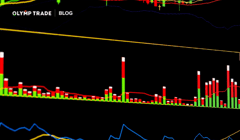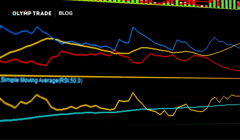
Stocks are one of the most popular investments today. As a novice trader, knowing in advance how to analyze stocks means you can be more confident in choosing them and maximize your earnings. One type of stock analysis that you can use is technical analysis, which involves the use of technical tools that represent data on historical prices that have occurred in the stock market.
Contents:
- Technical analysis of stocks
- Technical analysis indicators for stock trading
- Conducting technical analysis of stocks
- Conclusion
Interact with the underlined words and green dots to get additional details and explanations.
Additional context for the visuals.
Explanations and definitions of terms.
Technical analysis of stocks
Technical analysis is one of the methods used by investors and traders for stock investment. In short, this form of analysis helps traders make a decision on whether to buy or sell a stock. Investors and traders need to analyze a stock’s price movement, understand the conditions affecting its current price, and determine how the price will move in the future. When the conditions affecting the stock price have been determined, investors and traders are much less likely to mistakenly buy or sell it. Technical analysis tools can also be used to determine price trends.
For conducting technical analysis on stocks, there are some indicators that you first need to know about and know how to use. Indicators use a mathematical calculation based on historical price data and visualizes that data in the form of a line or other graphical elements on a chart. Indicators can recognize stock price trends and signal good moments to enter and exit the market.
Technical analysis tools are also used by investors looking to buy and hold stocks for the long term, whereas for traders, they are useful for determining which stocks will provide beneficial returns in the short term. With technical analysis, we can determine the right time to enter the market and the right time to exit the market.
Read more: How to pick stocks: Two different approaches
Technical analysis indicators for stock trading
Generally, technical indicators provide an overview of the supply and demand of stocks as well as a psychological snapshot of the market. In general, there are two basic types of technical analysis indicators that you need to know about:
Overlays
Lines that determine whether the stock price is going up or down. Overlays can be seen above or below the candle or bar. Moving averages and Bollinger Bands are examples of overlays.
Oscillators
These appear separately from the price movement chart and determine the beginning or end of a trend. Examples of oscillators are theStochastic oscillator, MACD or RSI.
MACD
MACD is used to show trend strength. This indicator consists of two lines, namely the MACD line and the signal line, which moves slower.
When above zero, the signal line indicates that an uptrend is in progress. Furthermore, if the line is below the zero point, then a downtrend is in progress.

Relative Strength Index (RSI)
The RSI is a reference line for conducting technical analysis of stocks, and is in the form of a middle number or zero. By default, the RSI is at 30 and 70, and indicates overbought and oversold conditions. If the price reaches or exceeds 70 on the RSI, then the asset is considered overbought. Conversely, if the price reaches or dips below 30, the asset is considered oversold.

The RSI can also be an indicator of support and resistance levels.
Stochastic oscillator
This indicator is used to measure the current price relative to the price range within a certain period. Similar to the RSI, the Stochastic oscillator consists of two lines located at zero and 100. The lines are usually blue and red. If the blue line is above the red line, it signals an uptrend, while the blue line intersecting the red line means that the trend is likely to be going down.

Conducting technical analysis of stocks
To do a technical analysis of stocks, you can start by looking at market movements, familiarizing yourself with technical analysis indicators and seeing how history repeats itself. Make sure you use market movements as a reference when doing analysis, as price movements themselves are a reflection of current conditions. They can be caused by a number of factors such as natural disasters, politics and the psychological condition of market participants. This is why it’s crucial to keep yourself up to speed with the news, ride the wave of volatility and develop a strong understanding of trading psychology — namely, your own.
Here’s a handy guide for a basic technical analysis method that we’ve put together:
- Observe a trend occurring on a stock’s price chart.
- Set support and resistance levels on the chart so that buy and sell signals are clearer.
- Use a moving average indicator to identify whether a stock is in an uptrend or a downtrend.
- Use an oscillator to determine the possibility of a change in the current trend.
- Set a minimum price limit or a Stop Loss to minimize losses in stock trading.
Conclusion
Traders conducting technical analysis of stocks are generally of the mindset that history repeats itself. Technical analysis tools highlight repeating patterns in stock prices, thus making it easier to trade on stocks successfully. It’s important to use indicators that best suit your needs for determining investment and trading quickly and precisely. To make things a bit easier for you, we’ve compiled a list of the 10 best trading indicators, go check it out! Technical analysis isn’t the answer to all a trader’s prayers, though. We also recommend familiarizing yourself with fundamental analysis techniques to help guide your investment decisions.
Join Olymp Trade, take advantage of the multiple trading tools available and become a force to be reckoned with on the markets!
Start Your JourneyRisk warning: The contents of this article do not constitute investment advice, and you bear sole responsibility for your trading activity and/or trading results.
The overall direction of a market or an asset’s price.
When an asset is trading at a value higher than it is actually worth. This results in the price inflating, then deflating as sellers take over the market.
When an asset is trading at a value lower than it is actually worth. This results in the price deflating, then inflating as buyers take over the market.
A price zone that always sits below the current price level and is where a falling price is likely to get rejected.
A price zone that always sits above the current price level and is where a rising price is likely to get rejected.
A postponed order that limits losses on a trade to a specified level.











